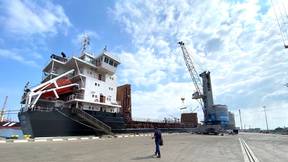NTSB Recommends Pipeline Operators Implement Safety Management Systems

The U.S. National Transportation Safety Board (NTSB) is recommending new notification alarms and procedures for potential incursions on pipelines and a change to an anchorage off the California coast following a crude oil release in 2021 caused by ship anchors damaging an underwater pipeline.NTSB investigators determined that the oil leak, which began on October 1, 2021, in San Pedro Bay, resulted from an anchor strike on the pipeline that occurred eight months earlier, when anchors…
In Focus: Talking Workboat Safety with AWO's Brian Bailey

Brian Bailey, Director of Safety and Environmental Stewardship for the American Waterways Operators (AWO), was recently named a 2020 Rising Star of Safety by the National Safety Council (NSC), a nonprofit public service organization promoting health and safety in the U.S. Marine News spoke with Bailey about workboat safety and the AWO’s mission to protect industry workers, assets and the environment.Please tell us a bit about yourself and your role at AWO.I’ve been with The American Waterways Operators as its Director of Safety & Environmental Stewardship since 2016…
NTSB Issues Report on Passenger Vessel Casualty

Insufficient Maintenance Program, Lack of Guidance Led to Passenger Vessel Fire. The National Transportation Safety Board determined during a public meeting held Tuesday that an insufficient preventative maintenance program and lack of guidance for responding to engine high-temperature conditions, led to the Jan. 14, 2018, fire aboard the small passenger vessel Island Lady, in the waters of the Pithlachascotee River, near Port Ritchey, Florida.The Island Lady was a 72-foot-long passenger vessel operated by Tropical Breeze Casino Cruz…
Plan for Safety: Leadership is Key

Effective leadership and a safety management system are the keys to success. Failure to lead has consequences. Over the last 20 years we have seen a dramatic shift in the way that our industry operates. When I started practicing law, many companies looked at safety planning as a balancing act where you weighed the costs associated with safety against the costs associated with working through employee claims. Unfortunately, our employees often ended up on the losing side of the balancing test. The industry goal seemed to be completing the task at hand, regardless of the risk.
AMSA to Cut Domestic Vessel Safety Red Tape
The Australian Maritime Safety Authority’s (AMSA) says its Domestic Vessel Division is to begin a thorough consultation process with domestic vessel operators, starting in Hervey Bay shortly in an attempt to streamline the National System and reduce red tape. (The National System for Domestic Commercial Vessels came into effect on July 1, 2013). AMSA Deputy Chief Executive Officer Mick Kinley explained that the National System had created one system for qualifications and standards for commercial operators nationwide. The Authority will run a series of consultation sessions across Australia to improve the system and streamline elements of it to make it easier and cheaper for the industry to comply with domestic vessel safety requirements.
NTSB Cites Propulsion Failure in 2010 Ferry Accident

Andrew J. Barberi Lacked Warning Alarm Indicating Propulsion Loss in 2010 Accident. On May 8, 2010, the 310-foot-long passenger ferry Andrew J. Barberi lost propulsion control of one its two cycloidal propellers as the vessel approached St. George terminal, Staten Island, New York. The loss of propulsion control resulted from a solenoid failure in one of the vessel's propulsion control panels. The crewmembers on board the Andrew J. Barberi were unaware that the propeller failed to respond to their commands until seconds before the ferry struck the terminal.
NTSB Report on Ferry, USCG Cutter Collision
The National Transportation Safety Board (NTSB) issued the report of its investigation into the collision between a U.S. passenger ferry and a U.S. Coast Guard cutter in Block Island Sound on July 2, 2008. Fog in the area limited visibility to about 500 yards. The report concludes that the bridge watch officers on both vessels failed to monitor their radars, sufficiently assess traffic, and compensate for limited visibility. They also failed to maintain a proper lookout and to sound appropriate fog signals. Among other things, the report recommends that all US ferries be required to install voyage data recorders and to implement safety management systems. MAR-11/01 (2/4/11). (Source: Bryant’s Maritime News)
Safety Board Determines Cause of SI Ferry Accident
The National Transportation Safety Board today determined that the probable cause of a fatal accident involving a Staten Island ferry was the assistant captain's unexplained incapacitation and the failure of the New York City Department of Transportation (NYC DOT) to implement and oversee safe, effective operating procedures for its ferries. On October 15, 2003, the Staten Island ferry Andrew J. Barberi, owned and operated by the NYC DOT, was at the end of a regularly scheduled trip from Manhattan to Staten Island when it struck a maintenance pier at the Staten Island Ferry terminal. Fifteen crewmembers and an estimated 1,500 passengers were on board. Ten passengers died in the accident and 70 were injured.
NTSB Releases SI Ferry Report
The National Transportation Safety Board (NTSB) released its report on the allision of the Staten Island ferry ANDREW J. BARBERI with the pier at St. George, Staten Island, New York on October 15, 2003. Eleven passengers died in the incident and 70 were injured. The primary causes of the casualty were the incapacitation of the assistant captain and the failure of the NYC Department of Transportation to implement and oversee safe, effective operating procedures on the ferries. A contributing cause was the failure of the captain to exercise his command responsibility. The NTSB recommends: that the NYC Department of Transportation implement a comprehensive safety management system and make related improvements…








